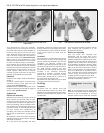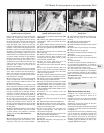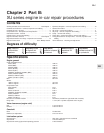
2 Valve clearances - checking
and adjustment
3
Note: The valve clearances must be checked
and adjusted only when the engine is cold.
1 The importance of having the valve
clearances correctly adjusted cannot be
overstressed, as they vitally affect the
performance of the engine. If the clearances are
too big, the engine will be noisy (characteristic
rattling or tapping noises) and engine efficiency
will be reduced, as the valves open too late and
close too early. A more serious problem arises if
the clearances are too small, however. If this is
the case, the valves may not close fully when
the engine is hot, resulting in serious damage to
the engine (eg. burnt valve seats and/or cylinder
head warping/cracking).
Checking
2 Remove the air cleaner and ducts as
described in the relevant Part of Chapter 4.
3 Disconnect the brake servo vacuum hose.
4 Remove the camshaft cover, trying not to
damage the gasket.
5 Have ready a pencil and paper to record the
measured clearances.
6 Turn the crankshaft using a spanner on the
crankshaft pulley bolt until the cam lobe
nearest the flywheel end of the engine is
pointing vertically upwards (see illustration).
7 Using feeler blades, measure the clearance
between the base of the cam and the cam
follower (see illustration). Record the
clearance.
8 Repeat the measurement for the other
seven valves, turning the crankshaft as
necessary so that the cam lobe in question is
always vertically upwards.
9 Calculate the difference between each
measured clearance and the desired value
(see Specifications). Note that the value for
inlet valves is different from that for exhaust.
Counting from either end of the engine, the
valve sequence is:
Exhaust - Inlet - Inlet - Exhaust - Exhaust -
Inlet - Inlet - Exhaust.
10 If any clearance measured is outside the
specified tolerance, adjustment must be carried
out as described below. If all clearances are
within tolerance, refit the camshaft cover, using
a new gasket if necessary. Note the diagnostic
socket and copper washer under the bolt at the
timing belt end on certain engines.
Adjustment
11 To adjust the clearances remove the
camshaft as described in Section 7.
12 Lift off a cam follower and its shim. Be
careful that the shim does not fall out of the
follower. Clean the shim and measure its
thickness with a micrometer (see
illustrations).
13 Refer to the clearance recorded for the
valve concerned. If the clearance was larger
than specified, a thicker shim must be fitted; if
the clearance was too small, a thinner shim
must be fitted.
Sample calculation - clearance too
large:
Desired clearance (A) 0.20 mm
Measured clearance (B) 0.28 mm
Difference (B - A) = + 0.08 mm
Original shim thickness 2.62 mm
Req’d shim thickness 2.62 + 0.08 = 2.70 mm
Sample calculation - clearance too
small:
Desired clearance (A) 0.40 mm
Measured clearance (B) 0.23 mm
Difference (B-A) = -0.17 mm
Original shim thickness 2.86 mm
Req’d shim thickness 2.86 - 0.17 = 2.69 mm
14 Shims are available in thicknesses from
1.650 to 4.000 mm, in steps of 0.025 mm in
the middle of the range and at the ends in
steps of 0.075 mm. Clean new shims before
measuring or fitting them.
15 Repeat the operations on the other cam
followers and shims, keeping each follower
identified so that it can be refitted in the same
position.
16 When reassembling, oil the shim and fit it
on the valve stem, then oil the cam follower
and lower it smoothly into position. If the
follower is raised at any stage the shim may
be dislodged.
17 When all the followers are in position with
their shims, refit the camshaft. Check the
valve clearances before refitting the timing
belt in case a mistake has been made and the
camshaft has to be removed again. With the
timing belt disconnected the camshaft will not
be moved by rotation of the crankshaft.
Before rotating the camshaft alone, position
all the pistons halfway down the bores to
avoid piston-to-valve contact.
XU series engine in-car repair procedures 2B•3
2B
2.6 Valve clearance is measured at point J and altered by shim (4)
2.7 Using feeler blades to measure a valve
clearance
2.12a Lift off the cam follower and
shim . . .
2.12b . . . then measure the shim thickness
with a micrometer
Turning the engine will be
easier if the spark plugs are
removed first - see Chapter 1.


















